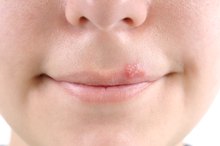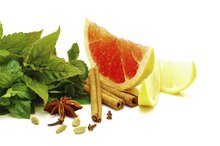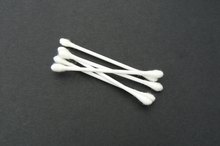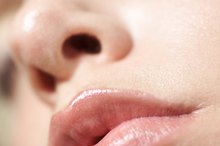Here it comes again -- that tingling feeling in your lip signaling the beginning of yet another cold sore. Unfortunately, there is no quick cure and once a cold sore begins, it usually has to run its course. **There are a few ways you may be able to ease the pain or speed the healing process by about 1 to 2 days, but baking soda is not one of them.
If you are experiencing serious medical symptoms, seek emergency treatment immediately.
** Although you may have heard that placing a paste made of baking soda on a cold sore will help, there is no scientific evidence that it is beneficial. Indeed, repeated use of baking soda may even prolong your cold sore.
Cold Sores: What to Expect
Cold sores, also known as fever blisters or herpes labialis, are skin lesions caused by the herpes simplex type 1 virus.
After an initial infection of the mouth or throat -- usually during childhood or adolescence -- the virus travels to a region on the underside of the brain called the trigeminal ganglion. It remains there for the rest of a person’s life, intermittently releasing virus particles that travel back to the mouth area, producing cold sores. About 20 to 40 percent of adults suffer from recurrent cold sores, according to the medical text "Human Herpesviruses: Biology, Therapy, and Immunoprophylaxis. 1"
Usually located on or near the lip, cold sores generally begin with a tingling or burning sensation.
This is followed by the appearance of a blister, which ruptures in 1 to 2 days to leave a painful, oozing open sore. This is soon covered by a crust that lasts another 8 to 10 days. Most cold sores resolve within 2 weeks of onset. Healing can be delayed if bacteria invade the area and cause a secondary infection.
- Cold sores, also known as fever blisters or herpes labialis, are skin lesions caused by the herpes simplex type 1 virus.
- This is followed by the appearance of a blister, which ruptures in 1 to 2 days to leave a painful, oozing open sore.
Baking Soda: Not the Solution
How to Get Rid of Cold Sore Scabs
Learn More
No studies have been published indicating that using baking soda will reduce the pain caused by cold sores, the extent of the lesions or the length of time cold sores persist. Baking soda can have a drying effect, so it may make oozing sores crust over faster -- but this does not mean they will go away more quickly than usual.
Indeed, the alkaline pH of baking soda may interfere with the normal healing of cold sores.
Although no studies have directly examined how an alkaline pH affects cold sores, changing the skin pH from its usual acidic value to an alkaline pH is potentially harmful. It can interfere with the normal function of skin cells and promote the growth of bacteria. Because of this, repeated use of baking soda paste may prolong the duration of cold sores.
- No studies have been published indicating that using baking soda will reduce the pain caused by cold sores, the extent of the lesions or the length of time cold sores persist.
- Because of this, repeated use of baking soda paste may prolong the duration of cold sores.
Simple Measures That Might Help
Cold sore pain can be reduced by applying a piece of ice or a cream containing a local numbing medicine, such as lidocaine, on the area. Oral nonsteroidal antiinflammatory medications, such as ibuprofen (Advil, Motrin) or naproxen (Aleve), can also provide pain relief but are generally not needed.
With cold sores on the lips, avoiding spicy and other irritating foods may help prevent worsening pain.
Before cold sores are fully covered by crust, avoiding exposure to the sun prevents additional damage caused by the sun’s rays. The American Academy of Dermatology (AAD) recommends using a lip balm with an SPF of 30 or higher 2.
- Cold sore pain can be reduced by applying a piece of ice or a cream containing a local numbing medicine, such as lidocaine, on the area.
Beneficial Medications
Cold Sore Stages
Learn More
A topical cream containing docosanol (Abreva) is the only over-the-counter medication approved by the U.S. Food and Drug Administration for the treatment of cold sores 4. It improves symptoms and reduces healing time by approximately 1 day. **Prescription creams containing antiviral drugs that block the growth of viruses, such as acyclovir (Zovirax) and penciclovir (Denavir), may also speed healing by about a day.
** Combination creams containing an antiviral drug and a corticosteroid -- such as acyclovir and hydrocortisone (Xerese) -- appear to be more effective than antiviral creams alone, according to a study published in "BMC Infectious Diseases" in February 2015.
Antiviral drugs in pill form, such as acyclovir, valacyclovir (Valtrex) and famciclovir (Famvir), may reduce the duration of cold sores by up to 2 days. Topical creams and oral medications are most effective when begun at the first sign of a cold sore.
- A topical cream containing docosanol (Abreva) is the only over-the-counter medication approved by the U.S. Food and Drug Administration for the treatment of cold sores 4, may also speed healing by about a day.
- Antiviral drugs in pill form, such as acyclovir, valacyclovir (Valtrex) and famciclovir (Famvir), may reduce the duration of cold sores by up to 2 days.
Additional Considerations
To reduce the likelihood of secondary bacterial infection, cold sores should be kept clean and scabs left intact. Cold sores are highly contagious. Until they are fully covered by scabs, the AAD recommends avoiding close contact with others, not sharing personal items like lip balm or razors, and thorough washing of the hands after touching a cold sore.
It is particularly important to avoid transmitting the cold sore virus to babies, people with eczema and people with an impaired immune system, such as those with HIV or receiving cancer treatment. These individuals are susceptible to developing severe, life-threatening infections from the herpes simplex type 1 virus.
Most healthy individuals do not require medical care for cold sores. The AAD recommends seeing a doctor if you have: -- Eczema. -- A weakened immune system. -- A cold sore near the eye.
-- A cold sore lasting more than 15 days. -- Cold sores occurring several times per year.
Reviewed by: Tina M. St. John, M.D.
- To reduce the likelihood of secondary bacterial infection, cold sores should be kept clean and scabs left intact.
- Until they are fully covered by scabs, the AAD recommends avoiding close contact with others, not sharing personal items like lip balm or razors, and thorough washing of the hands after touching a cold sore.
Related Articles
References
- Human Herpesviruses: Biology, Therapy, and Immunoprophylaxis; Ann Arvin et al.
- American Academy of Dermatology: Cold Sores
- Bioengineering of the Skin: Water and the Stratum Corneum, 2nd Edition; Joachim W. Fluhr et al.
- DailyMed: Abreva -- Docosanol Cream
- The Journal of Family Practice: What Are the Best Treatments for Herpes Labialis?
- Canadian Family Physician: Treatment and Prevention of Herpes Labialis
- BMC Infectious Diseases: Effectiveness of Topical Corticosteroids in Addition to Antiviral Therapy in the Management of Recurrent Herpes Labialis: A Systematic Review and Meta-analysis
- Chi CC, Wang SH, Delamere FM, Wojnarowska F, Peters MC, Kanjirath PP. Interventions for prevention of herpes simplex labialis (cold sores on the lips). Cochrane Database Syst Rev. 2015;(8):CD010095. doi:10.1002/14651858.CD010095.pub2
- Mailoo VJ, Rampes S. Lysine for herpes simplex prophylaxis: A review of the evidence. Integr Med (Encinitas). 2017;16(3):42-46.
- Cunningham A, Griffiths P, Leone P, et al. Current management and recommendations for access to antiviral therapy of herpes labialis. J Clin Virol. 2012;53(1):6-11. doi:10.1016/j.jcv.2011.08.003
- Cold Sores. MedlinePlus 18 Sep 13. US National Library of Medicine. Department of Health and Human Services. 24 Oct 13.
- Cold Sore. Diseases and Conditions 23 May 13. Mayo Foundation for Medical Education and Research. 24 Oct 13.









